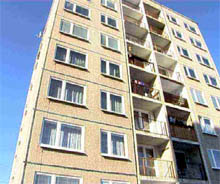
Germany is trying to use old panels for building family houses
 |
Structures made from panels can reportedly be up to 30 percent cheaper than properties made from conventional materials, according to workers at the Institute for Preservation and Modernization of Buildings at the Technical University of Berlin, and the panels are said to be remarkably well-preserved. The first family homes made from former panel buildings are already being created.
"Our current research has shown that it is a very good material and that it can be reused without any problems," said Frank Vogdt, deputy director of the institute, to ČTK. After cleaning, inspection, and cutting, the panels serve as building components for another construction.
According to experts, concrete pieces are architecturally flexible and can be adapted to plans for a completely ordinary home. "You do not think about the fact that the material comes from a panel building," explains Vogdt.
The rough structure of a villa in Schildow, Brandenburg, on the edge of Berlin really looks like an ordinary family house. Except that it is, including the roof, made from panels that were recently part of a panel housing estate in the Berlin district of Marzahn.
The panel frame will ultimately not be visible. Insulation and plaster will be applied to the rough structure. So far, the construction is 24 to 27 percent cheaper than buildings made from bricks or prefabricated houses. "These are the first plans; they can definitely be improved," says Vogdt. The owner wants to use the savings to place solar panels on the roof and partially grass it over.
In East Germany, there are approximately 300,000 empty panel apartments. If the use of panels proves successful, experts foresee broad applications. "In Germany, there is a demand for family homes or duplexes," explains Vogdt. When it comes to multi-story buildings, people prefer four- or five-story constructions, not eleven-story giants. "With these elements, we can build up to three-story houses," explains project leader Claus Asam.
Experts are therefore considering the possibility that in the future, the upper floors of high panel buildings on estates may be dismantled and lower multi-story houses or family homes could be built directly on site from them.
Could the "family panel building" have no drawbacks? "When builders criticize, they talk about how hard the concrete walls are that you can't even hammer a nail into them," admits Asam. "But some say it’s a good thing because it finally allows them to hang kitchen cabinets without them falling on their heads. In the end, though, you need different tools at home. A real drill, while in a brick house you can do it with a nail and hammer," he adds.
Germany is trying to deal with its concrete legacy in every possible way. The dismantling of panel housing estates is also supported by the governmental program Stadtumbau Ost, or Urban Reconstruction of the East.
The English translation is powered by AI tool. Switch to Czech to view the original text source.
0 comments
add comment










